How To Pick Glove Ratings: Our Guide To EN-Standards
There are several types of gloves available to purchase for a reason. You should avoid making the mistake of assuming that any type of glove can be used for any type of work you undertake, as this can bring its own set of dangers. That's why gloves are rated into three separate categories and all come under different standards - they all depend on your situation. Here's how to pick glove ratings in line with EN-standards.
There Are 3 Top-Level Categories Of Gloves
- Category One (1) - Minimal Handling Risk
- Category Two (2) - Intermediate Handling Risk
- Category Three (3) - High Level of Risk
Protective gloves can be divided into three categories, depending on the type and which danger or risk the gloves should be protecting against.
Gloves designed for minimal risks are placed in category one. Gloves designed to be suitable for intermediate risks are placed in category two. Gloves that are designed to protect against the highest levels of risk, such as corrosive acids, high heat and [something] are placed in category three.
However, the EN standards can be broken down further.
Before looking in depth at the standards, here's the recommended glove for each respective standard and which kind of roles they're best suited for:
Standard Recommended Glove Ideal For
EN 420 Portwest Canadian Rigger Glove Drivers and Riggers
EN 388 Portwest Cut 5 PU Palm Glove Cut-resistance
EN 407 Portwest Welders Gauntlet Welding and thermal hazards
EN 12477 Portwest Ambi Dex Welding Gauntlet Welding and mechanical hazards
EN 374 Portwest Nitrosafe Chemical Gauntlet Chemical, oil and food industries
EN 511 Portwest Antarctica Insulatex Glove Operating in cold temperatures
EN 10819 Portwest Anti Vibration Glove Dealing with power tools
And here's a breakdown of each standard in more detail...
EN 420 This standard defines the general requirements for protective gloves in terms of construction, fitness of purpose, safety etc. The pH of the gloves should be as close as possible to neutral. The gloves themselves should not impose a risk or cause injury. Gloves must feature specific details This standard is seen as the benchmark of safety - all safety gloves must earn this standard first. Not every glove will have EN 420 as an accolade as it consists of fairly commonsense specifications. Leather gloves should have a pH value between 3.5 - 9.5. Recommended glove: portwest canadian rigger glove
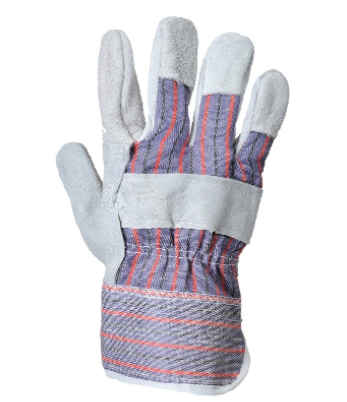
Portwest Canadian Rigger Glove
A popular leather style which features vein protection. The cotton backing increases comfort and ventilation. Ideal for drivers and riggers.
EN 388 These are gloves which provide protection from mechanical risks. Protection against hazards is represented by four numbers, each one representing test performance against specific hazards. 1 - Resistance to abrasion. Based on the number of cycles required to abrade through the gloves. Protection factor is indicated on a scale of 1-4 depending on how many revolutions are required to make a hole in the materials. 2 - Blade cut resistance. Based on the number of cycles required to cut through glove at a constant speed. Protection factor is indicated on a scale of 1-4. 3 - Tear resistance. Based on the amount of force required to tear the sample. Protection factor is then indicated on a scale of 1-4. 4 - Puncture resistance. Based on the amount of force required to pierce the gloves. Protection factor is indicated on a scale of 1-4.

Image Credit: Cut Safe
RECOMMENDED GLOVE: PORTWEST CUT 5 PU Palm glove
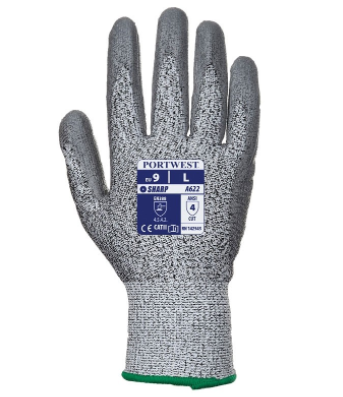
Portwest Cut 5 PU Palm Glove
This glove offers maximum protection against cuts and sharp objects. Ideal for workers searching for cut-resistant gloves.
EN 407 Gloves under this standard have been tested under six different tests designed to cover a range of threats. The higher the number in each test, the better the result. This standard is used to determine the level of protection that gloves have against a number of thermal hazards. Test #1 - The resistance to flammability. Test #2 - The resistance to contact heat. Test #3 - The resistance to convective heat. Test #4 - The resistance to radiant heat. Test #5 - The resistance to small splashes of molten metal. Test #6 - The resistance to large splashes of molten metal. RECOMMENDED GLOVE: PORTWEST Welders gauntlet
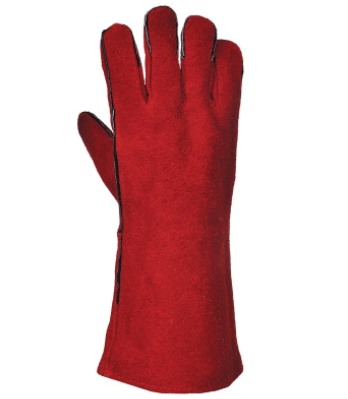
Portwest Welders Gauntlet
This style is ideal for workers who work in welding or operate under any other thermal hazards.
EN 12477 This standard describes how the gloves are designed to provide protection for both hands and wrists while welding or similar work. This standard is a combination of testing EN 388 and EN 407. Gloves under this standard will provide resistance to small splashes of molten motel, short exposure to convective heat, radiant heat and contact heat along with mechanical risks. Type A refers to gloves which provide higher protection against heat. Type B refers to gloves which provide lower protection against heat, but are more flexible. RECOMMENDED GLOVE: portwest ambi dex welding gauntlet
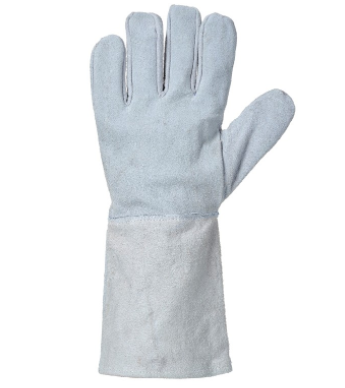
Portwest Ambi Dex Welding Gauntlet
This ambidextrous workers glove offers thermal protection to welders or against any other thermal and mechanical hazards.
EN 374 Gloves under this standard give protection from chemicals and micro-organisms. These gloves are tested and approved chemical gloves to withstand over 15,000 different chemicals and over 60,000 products in various industries. In order to pick the safest glove, you must find out the names of chemicals you will work with and how long you will be in contact with said chemicals. Gloves tested for this standard must be liquid-proof and can't be penetrated when undergoing an air or water leak test. RECOMMENDED GLOVE: PORTWEST nitrosafe chemical gauntlet
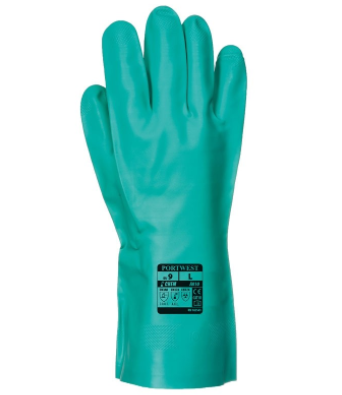
Portwest Nitrosafe Chemical Gauntlet
Ideal for workers look for a glove with enhanced grip. Recommended for use in the chemical, oil and food industries.
EN 511 These gloves are designed to provide protection from cold. Two things are measured with the glove: how the glove's material leads cold and the material's insulating capacity. The gloves' pictogram will show either a 0 or a 1. 0 indicates that the gloves suffer from water penetration after 30 minutes while a 1 indicates the gloves suffer from no water penetration after 30 minutes. The higher performance level of the glove, the better the insulating capacity. RECOMMENDED GLOVE: PORTWEST Antarctica Insulatex Glove
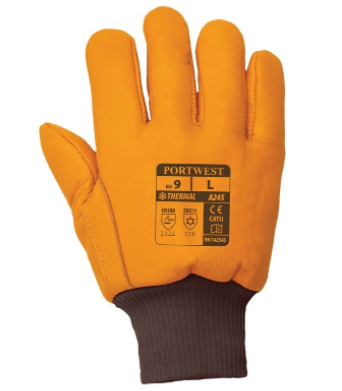
Portwest Antarctica Insulatex Glove
This glove features premium quality cow grain leather with Insulatex lining for enhanced warmth. This is the ideal style for coldstore applications and workers operating in cold temperatures.
EN 10819 Gloves under this standard provide protection from vibration. The standard implies that gloves shouldn't enhance vibrations with a moderately strong frequency (31.5 Hz to 200 Hz). When there's a high frequency (200 Hz to 1250 Hz), the gloves will reduce the levels of vibration by 40%. RECOMMENDED GLOVE: PORTWEST anti vibration glove
Portwest Anti Vibration Glove
This glove is specifically designed to reduce the effects of impact and vibration. Ideal for workers operating with power tools, jackhammers, concrete breakers and more.
By following and understanding the above standards and glove ratings, you're able to put yourself in a much better position when it comes to purchasing gloves that will keep you safe from specific hazards.






